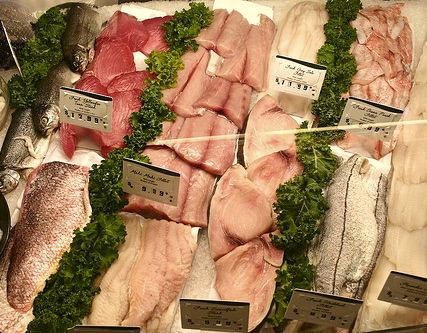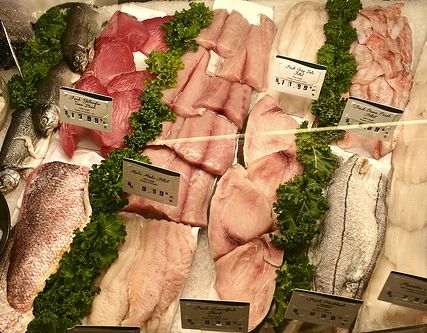 Photo: Prize PonyThere’s no question that animal protein is losing cultural prominence. It’s now common for high-profile chefs to embrace the notion that meat no longer needs to sit squarely in the center of a plate, flanked by a starch at ten o’clock, and a vegetable at six. High profile eaters like President Clinton and Mark Bittman have publicly embraced vegetable-centric diets, Meatless Monday has taken off around the nation, and when we do eat meat, more and more of us are getting comfortable eating “nose-to-tail.” This reconsideration of animal protein is starting to feel (almost) mainstream — which is why it’s so curious that seafood has largely been absent from the discussion.
Photo: Prize PonyThere’s no question that animal protein is losing cultural prominence. It’s now common for high-profile chefs to embrace the notion that meat no longer needs to sit squarely in the center of a plate, flanked by a starch at ten o’clock, and a vegetable at six. High profile eaters like President Clinton and Mark Bittman have publicly embraced vegetable-centric diets, Meatless Monday has taken off around the nation, and when we do eat meat, more and more of us are getting comfortable eating “nose-to-tail.” This reconsideration of animal protein is starting to feel (almost) mainstream — which is why it’s so curious that seafood has largely been absent from the discussion.
When it comes to fish, smaller is better — but not just for the usual reasons. On top of general quantity control, new science backs up the sustainability of serving up smaller fillets. According to a recent paper by Dr. Michael Tlusty, director of research for the New England Aquarium in Boston, size matters when it comes to farmed fish.
According to the National Fisheries Institute’s top ten seafood list of farmed fish released last week, we remain a nation of shrimp and salmon eaters, while the rest of the world uses aquaculture to grow lower-on-the-chain foods like seaweed and carp, which Americans rarely think to eat. Steering eaters away from traditionally farmed (and resource-intensive) seafood, like shrimp and salmon, and towards options like trout and catfish, has long been seen as a move in the right direction. Now fillet size is also coming into focus as an important piece of the puzzle.
The Tlusty study took a closer look at three species — catfish, rainbow trout and sablefish — and found that younger fish convert feed at a more efficient rate than older, larger fish. Harvesting them at a younger age produces smaller fillets for chefs to plate, but it also means that producers can push sustainability practices further by taking a farmed fish that’s already rated “green” by groups like the Monterey Bay Aquarium’s Seafood Watch Program and making it even greener.
“If you look at a single catfish pond, for example, you can get 60 percent more biomass out of it if you grow small fish,” says Tlusty. In other words, the same amount of feed can result in a lot more fish. The hurdle, he adds, is getting chefs and retailers to embrace those smaller fillets.
Kelly McCown, executive chef at Ella Dining Room and Bar in Sacramento, is the rare chef who espouses this kind of thinking. He requested his supplier at Passmore Ranch to harvest trout at six ounces instead of the more market-ready eight-ounce size.
“You don’t need a gargantuan piece of fish on your plate to have a good meal,” says McCown. “I give guests enough to feel satisfied [it’s a] good value. But to grow a bigger fish, and then put the whole portion on a plate just for someone to bring it home in a to-go box that gets forgotten in the back of the refrigerator? That doesn’t make sense.”
Dr. George Leonard, aquaculture program director at Ocean Conservancy, says he’s heartened by this application of new aquaculture knowledge into the way sustainability-conscious chefs cook. But he also sees the limits to the solution.
“While the proposal is a biological truism — that as fish get larger, they’re poorer feed converters — it’s only going to get us part way there. It’s an incremental improvement, but fundamentally, we need to figure out how to stop feeding wild fish to farmed fish,” says Leonard
There’s another important nuance: Tlusty’s premise does not apply to wild fish.
“In aquaculture, you’re not eating the brood stock; you never touch them,” he explains. In other words, there is one set of fish solely raised for breeding purposes while the others are harvested and eaten. Whereas, in the case of wild fish, he says, “eating juveniles isn’t sustainable. You need to wait for them to get to the size they need to be to reproduce,” says Tlusty.
That’s an important point, but the fundamental idea of eating smaller portions can be applied to wild fish, too — if done carefully. Eaters need to be aware of the difference between sustainable small fish, like sardines, and juvenile versions of large fish harvested before reproductive maturity, like bluefin tuna or freshwater eel.
Other chefs, like Edward Lee of 610 Magnolia in Louisville, Kentucky, are already rethinking the way they plate seafood regardless of its farmed or wild-caught status.
“If we do this with pigs, cows and lambs — use all parts of the animal — why can’t we do the same thing with fish?” says Lee. “Think of salmon. You rarely see the collar, the tail meat, or the belly being widely utilized.”
What you won’t find at 610 Magnolia is an entrée where a slab of swordfish steak is the plated star: Lee cuts his portions smaller and pairs different species of fish together on one plate. Lee even went so far as to change his entire menu so no entrée features a single fish protein.
“Pairing different fish together gives guests a whole panorama of tastes. It’s more fun for them and more economical for us. The only downside is the plating is more complicated,” he said.
For chef Jeff Rossman at farm-to-table restaurant Terra in San Diego, preventing waste is a challenge when working with smaller fish.
“If we’re looking at six-ounce portions, and the fillets come in at 16 ounces, or the tail portion is very thin, then we have to [consider] consistency in portioning and cooking times,” he says.
But Rossman believes the difference he’s making is worth the effort. And he’s not alone.
“To become global citizens, we need to eat smarter,” says Tlusty. “With aquaculture, we have control over how things are produced, and we can do that.”
For fish, that starts with a less-heaping helping.




